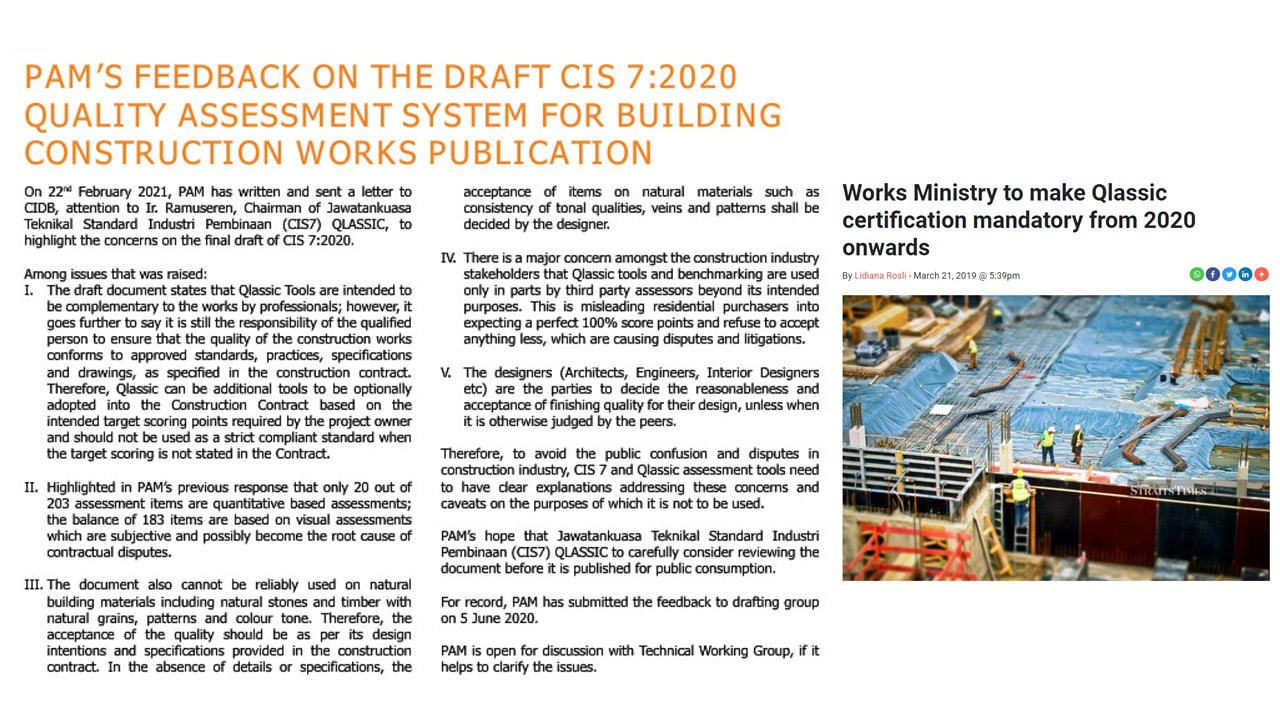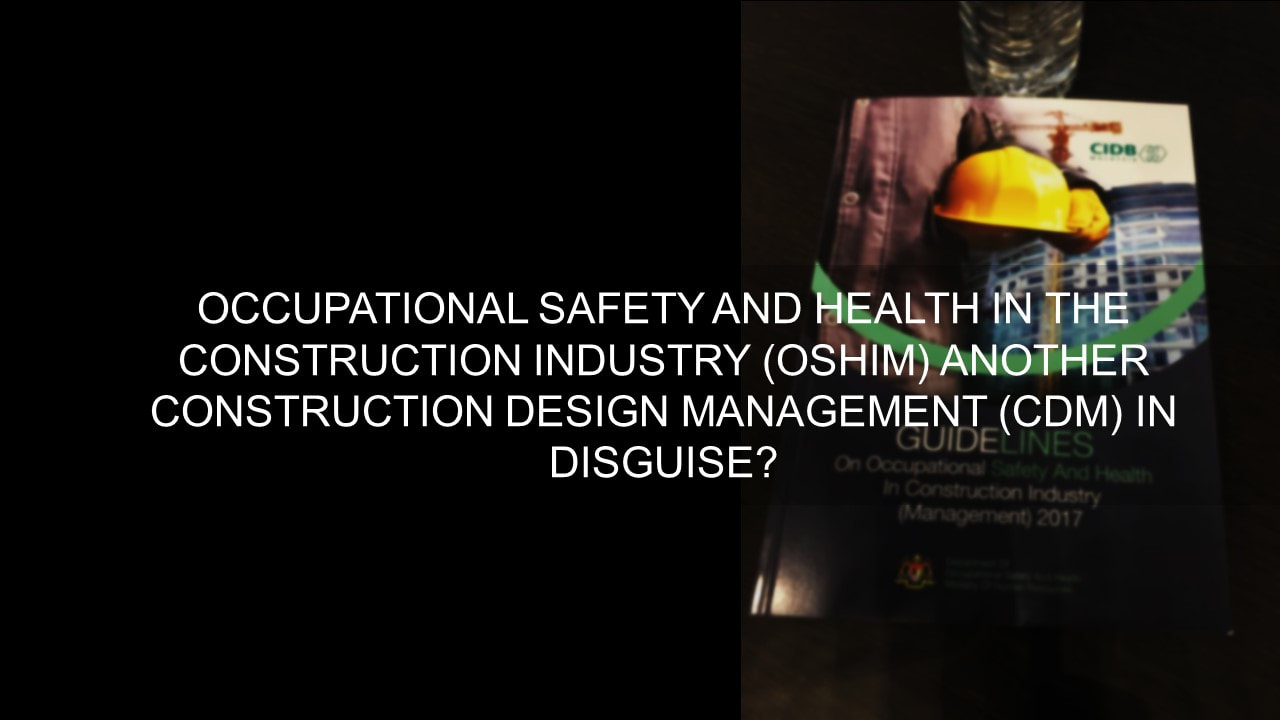A QUALITY STANDARD APPLIED TO ALL CONSTRUCTION WORK?Defect is such a ‘dirty’ word. Home owners shun it. Contractors hate it. Unfortunately, government agencies and Architects will have to deal with it. Occasionally, defects are the source of incomes to third-parties, such as, claim-consultants (some are lawyers); forensic-experts; and defect-rectification contractors, alongside the entire ‘eco-system’ that support the ‘defect-rectification’ industries from the tribunals to the supplier of materials and ‘quality-assessment’ course/standard provider. In reality, a discomfort for owners, are indeed ‘cari-makan’ tools/opportunity to others and I said it out loud on the basis that any ‘services’ that can solve people’s problem is a good industry with ‘profitability’.
So, the other issue related to defects are, what standards to apply? How to determine a defect is a defect? Who to determine what? When can mitigating action be taken? Why such measure be taken? Answering such is a ‘monumental efforts’ resulted in many man-hours and public-funded spending aka taskforce, committee, working-group and so-forth both at institutional and governmental level. However, this write-up only limit to a question, is CIS-7 a standard to be adopted generally to the construction industry? Foremost, CIS-7[1] is a standard adopted by the CIDB[2], initially borrowed from Singapore’s CONQUAS[3] system of quality assessment in the construction industry. It has since undergone various ‘metamorphosis’ and had been once dished out as the ‘knight in shimmering armour’ to be mandated by the Work Ministry in 2020[4], that has yet to see the ‘light of the day’. Unfortunately, CIS-7 of QLASSIC[5] is not an acceptable ‘standalone’ industrial standards because they are quality assessment-standards, optional only if the parties decided to adopt when they go into a building contract. Why it cannot be made, mandatory? Regardless if a building costs ten of thousands or millions, defects are generically applied and occur without any constraint of costs and value. However, such costs and values can determine if the quality of works can meet a certain performance standard, thus evaluative tools such as CIS-7 of QLASSIC and CONQUAS are designed for such, rendered these optional, not mandatory. As it stands now, CIS-7 of QLASSIC cannot be a subjected standards adopted in the court of law to be applied nationwide.[6] What if it is to be made mandatory? Such may have legal-repercussion throughout. Foremost, the UBBL only warrants the suitability of materials and workmanship[7] with the ultimate question of what is defined as suitability? Whose standards? Under The Street, Drainage & Building Act 1974 (amended 2007) SDBA, the “principal submitting person” means a qualified person who submits building plans to the local authority for approval in accordance with this Act.[8] Meaning he is the principal submitting person to undertake the statutory responsibility, thus the quality standards must be in accordance to his specifications, not CIS-7 of QLASSIC. So, how on earth can CIDB overrides the SDBA 2007? Even causation in tort needs proof and that is not going to be easy by just relying on res ipsa loquitur.[9] Construction law goes into the extent of ‘risk-allocation’ as to latent and patent defects that cast no meaning to the general public. The voluminous standards by the BSI, AS, Euro-Code and our MS, governing materials, tools, applications and so forth may only make sense to the professionals and are constantly changing. So, where are we? PAM[10] has objected to this application of CIS-7 of QLASSIC as national-standard.[11] Knowing how things move within the ‘chain of deliveries’ architects will be ‘side-lined’, as reported.[12] It will comes a time when a CIDB QLASSIC Assessor will be dictating to the Architects as to ‘which qualities prevailed’, while running-free if the building collapsed.[13] Do Architects want this to be the reality? ---------------------------------------------- [1] CIS-7:2014 Quality Assessment System for Building Construction Works [2] Construction Industry Development Board (CIDB) [3] Construction Quality Assessment System (CONQUAS) [4] <https://www.nst.com.my/business/2019/03/471636/works-ministry-make-qlassic-certification-mandatory-2020-onwards> [5] Quality Assessment System in Construction (QLASSIC) [6] <http://rehdainstitute.com/wp-content/uploads/2019/12/Mr.-Mohammad-Faizal-Abdul-Hamid.pdf>: the use of any standards is voluntary & compliance with this document does not in itself confer immunity from legal and contractual obligations. [7] S.53 UBBL 1984 [8] S.3(e) SDBA 2007 [9] Latin maxim, meaning ‘let the thing (evidence) speaks for itself’, in law of evidence. [10] Pertubuhan Arkitek Malaysia (PAM) [11] Berita Arkitek BA (Feb 2021): PAM’s Feedback on the Draft CIS 7:2020 [12] Berita Arkitek BA (Feb 2021): Report of PAM Representatives on Government Standing Committees, Councils and Boards (Jawatankuasa Teknikal Standard Industri Pembinaan (CIS7) QLASSIC) by Ar. Steven Thang [13] S.258 UBBL 1984
0 Comments
OCCUPATIONAL SAFETY AND HEALTH IN THE CONSTRUCTION INDUSTRY (OSHCIM) ANOTHER CONSTRUCTION DESIGN MANAGEMENT (CDM) IN DISGUISE?I am re-writing this article on Occupational Safety & Health in Construction Industry Management (OSHCIM), after having much clarity as to where it begins. OSHCIM is just another hybrid of Construction Design Management (CDM) UK and Design for Safety (DFS) Singapore and a direct adoption of Construction soon to be enacted, will be another matter to be dealt with by the construction industry. It adds up additional cost, 2% out of the developer's pocket, well much decent compared to the architect's fee.
So to speak, this new regulations will significantly shift the risks upstream back to the architect. Blatantly erred, to say that architect like it or not, has to owned up to their design liabilities and what has this regulation imposed are not much the different. Yet, they forgot negligence has to be proven. As this legislation that foresee to be gazetted 6 months down the road, Singapore took 6 years, imposed a self-declaration of design liabilities, that they called risks, voluntarily into a document called risk-register. This document will be expended as it snowballs downstream right to the occupier. The question remain to be seen is, how easy would the occupier take this document to find faults with each and every party in the delivery system, since it is already a self-confessed 'sin'? This document has no privileges in evidence law. One may say, just 'simply' do it and make it as ambiguous as possible? Nay, CIDB will imposed a self-regulatory mechanism with a paid consultant monitoring this processes, full time at your expanse via the weekly OSHCIM meeting. They will not provide solutions to the problem as they would not want a piece of the design liabilities from the architect, they are basically checker to make sure that the architect crosses the T n dots the I, in their self-imposed declarations of liabilities. Least to say, they imposed strict rules for the architect to owned up to their liabilities under the spirit of if you fail to plan you should first plan to fail, in that way you will minimize risks downstream. In reality the architect's risk has not reduced an ounce but has increased significantly as it includes other risks as well particularly from the builders. It becomes clear that CIDB via this mechanism manage to pass the buck of their conundrum upstream to the architect in a subtle way as the dialogue now imposes that architect is responsible for Contractor's safety on site and the ministry buys it! Given the scenario of below cost acceptable tender sum is taken by foreign contractors and 0.5% dirt cheap architectural fees were forced through our throats, now, plaguing the profession and the construction industry at large, do the architects want to support it? A PAGE FROM Construction Design Management (CDM) UK: To critically-evaluate the ‘health and safety’ duties imposed upon contractor, one has to consider what are the common-law and Construction Design Management Regulations 2015 (CDM2015) enforced in the UK? How would Employer’s positions be different if Employer acted as both principal-designer and project-manager? Historically, Health and Safety at Work Act 1974 (1974 Act) empowers Construction Design Management (CDM) – Regulation 1994 (CDM1994)[1]; with employers’ duty ensuring, health, safety and welfare at-work, applied to the other-persons[2]; without-risk[3]. Prior to 1974Act, workers-welfare was governed by Factories Act1961, applied in the construction-industry. Failure to integrate CDM-regulations into ‘non-domestic’[4] construction-practices[5] are criminal-offences[6]; HSE-inspectors empowered to inspects/take documented-copy/samples[7]. CDM has since been improved/updated from CDM1994, CDM2007 to the current, CDM2015; promotes identification-elimination of Health and Safety risks from ‘project-lifecycle’ commencing, ‘pre-construction-phase’, right-up to post-occupational, i.e. building-decommissioning; with different Health and Safety role/responsibility vested-upon different stakeholders, i.e. principal-designer/Architect/Engineer/Client[8] at ‘pre-construction-phase’[9]; principal-contractor at ‘construction-phase’[10]; QS/Procurement-Managers at ‘procurement’ right-up to Maintenance-managers/End-users at ‘post-occupational’. CDM2015 required the HS-File to be kept, maintained, updated and transferred from one stakeholders to another, throughout the project-lifecycle.[11] In addition, it will be necessary to ensure that right-people appointed-early, have time-to-review materials and involved in setting-up processes.[12] If none-appointed, client obliged to-carry out these-duties.[13] Rationales are, client is key-role-stakeholder[14], has overall-control; can properly-managed at all-stages[15]; if insufficient-knowledge/resources, he employs designer/competent-people to-assist[16]; managing-project, i.e. ‘suitable-project-management’. “Suitability”, means work without-risk[17]. He makes-available ‘pre-construction information’ i.e. drawings, Health and Safety-file, surveys, to designer/contractor, ensuring phase-plan completion, where designer/contractor complies with duties, allocation of sufficient-‘time/resources’, continue ‘maintained/reviewed’ Health and Safety risks[18]; and future-appointments[19]; provide facilities such-as sanitary, washing, drinking-water, changing-rooms and rest-facilities.[20] Traditionally, CDM2007 was meant to stamp-out deficiencies arising from tight-budget, care-less site-cultural/attitudes, and motivates promotion of safe-place on construction-work. A stricter-legislation would influence construction-workers be more-observant to Health and Safety risks. Thus, common-law on man-slaughter since codified, as Corporate-Manslaughter and Homicide Act2007 (The-Act), to address weaknesses of ‘identification-principle’ formerly, only “hands-on” directors were-convicted, instead of ‘main-culprits’.[21] The-Act determines corporate-liability by judging management-adequacy across organisation. Penalties imposed, unlimited-fine; remedial-order; publicity-order; compensation-order; prosecution-costs order; and victim-surcharge, with sentencing not-less than £500,000. However, CDM2007, issues with interpretation, bureaucracy, and onerous-competency resulted lack-of-coordination in preconstruction-phase; coordinators’ late-appointment, lack of resources and failure to-include coordinators into design-team. Changes/amendment to CDM2007 were logical. CDM2015 devised to address Health and Safety concerns, previously vested-upon ‘competent-person’, now to designers/client whom are influential from the outset; reduce overlapping-trend of multiple-accreditations, by removal of ‘Approved-Code-of-Practice’; embedding CDM2015 into smaller-projects, where majority accidents-occur, by requiring ‘construction-phase plan’. Construction-industry stakeholders have to be aware of duties prescribed to them; when project becomes notifiable to the relevant-authority, i.e. notice be-given, in-writing to HSE prior to construction. Moreover, CDM2015, although instituted significant-additions, has weaknesses i.e. ‘domestic-client’ often unaware of such-duties by-default, unlikely to be appointed-to contractor/architect; confusion in appointing principal-designer for ‘pre-construction’, and principal-contractor for ‘construction-phase’; domestic-premises are ‘small-timer’ ignorance of CDM, will typically fall-out from the often-changing threshold-notification to HSE[22]; where 1974-Act are oblivious to most domestic-work; adding-up bureaucratic red-tapes, i.e. HS-File cum Health and Safety Coordination-Meeting; differing-opinions to the absent of CDM-Coordinator; for costs-reduction having architect, double-up as principal-designer with additional-burden/responsibilities; if failing to-appoint, client takes-upon himself, such-extra-burden; even if architect willing, it will not be ‘pro-bono’[23]; obscurity of ‘designer’, a contextual-term devoid of any professionally-linked core-competency but merely Health and Safety administrative role; such principal-designer ‘necessary-skills’ in-lieu of CDM2007’s-‘competence’ are mere-semantic; opportune upon others to-provide ‘training-ground’ as ‘cash-cow’; HSE’s-premise, ‘client, most-influential throughout the-project’ will not-change the fact that ‘client is-king’, often CDM worst-offenders[24]; that takes-account client assuming principal-designer has added vested-duties, include those outside CDM-Coordinator’s scope. In Contractor’s positions as principal-designer, its role, focus for Health and Safety issues rather than ‘outsourcing’ it; the definition of “designer”, not-exclusive, can also be client/contractor.[25] The term-“Design”, includes drawings, design-details, specification, generally assumed by Architects, Engineers, Surveyors, others; anyone who specifies/alters design, specifies use of particular-method of work/material; who-specifies building-layout; MAP-Engineers; contractors; and temporary-works engineers, but under CDM2015 designers are ‘unique-position’ for-purpose of risks-reduction/hazards-identification with responsibilities, not-confined to construction-phase but to-covers Health and Safety issues, post-completion. Contractor will resumes Health and Safety duties[26], to ensures his-awareness(as Client, too), i.e. know client’s-duty, the work-amount; risks-elimination, i.e. take-account of general-principle of prevention[27], pre-construction information, in place, eliminate-foreseeable risks[28], maintain/cleaning the-structure, alongside cost, fitness-for-purpose, aesthetics and environmental impact[29], ensuring other-designers compliance[30], cooperation[31], liaise with principal-contractor[32]; providing design-information[33], delivered-effectively; includes providing other “significant-risks” information; to identify risks-arising from design-integration; with design-reviews scope made-available. Designers do-not have-to, take-account of, unforeseeable-hazards and risks; possible future-uses of structures; to-specify construction-methods; to-exercise any Health and Safety management function over contractors. Principal-designer is not by-qualification but by safety-influences, i.e. in organisational-abilities.[34] Contractor’s positions as project-manager(PM), under CDM2015, is obliged-to resume principal-contractor’s role covering ‘construction-phase’ under non-domestic, notifiable-project, and to provide relevant-information to HSE, allowing them to monitor projects; accordance to HSE-thresholds[35]; with additional-information[36], i.e. planned-commencement/duration; time-allocation[37]; workers-number(max); and CDM-compliance declaration.[38] Principal-contractor[39] is person-appointed with specific-duties[40], in influencing Health and Safety management in ‘construction-phase’, i.e. particular-work on ‘design-technical-organisational’[41], ‘general-prevention’ of risks[42], manage other-contractors[43]; consult-engage with workers[44] via, site-induction[45]; unauthorised-access prohibition, facilities[46]; principal-designer liaison[47]; specific-obligations[48], i.e. competent-workers[49]; work-supervision[50]; information to workers[51]; unauthorised-access prevention[52]; welfare-facilities[53]. Whereas, ‘construction-phase plan’, “set-out Health and Safety arrangements and site-rules” for dangerous-risks[54]; a ‘living-document’; criteria are relevancy; sufficient-detail; proportionate to project-scale/complexity. Health and Safety File made by principal-designer; kept up-to-date. Concluding, notwithstanding the noble-intention of CDM2015 to document risks-preventions, it is not without its-setbacks; although CDM has been adopted in various-jurisdiction[55]; the same uncertainty-fears permeate among industry-stakeholders. Contractor’s position as both principal-designer and PM, are indifference as of the overarching client’s-duty under CDM2015; applied from ‘preconstruction’ to ‘post-construction’ phases. --------------------------------------- [1] Part1.1974Act [2] S.2-3.1974Act [3] S.4.1974Act [4] Regulations make distinction between “domestic”, i.e. work-done on their private-home and “nondomestic”, i.e. work in-connection with furtherance of business [5] Construction-work includes building/engineering-works; retrofitting, renovations, demolition, etc; also include, preparation-planning; pre-fabs assembly; waste-removal; maintenance-repairs; exclude mining and its related-works. Structure is construe as, building, either temporary/permanent-materials; railways; dock-harbour; tunnel-bridge; etc. include formworks/scaffolds. [6] S.20-22.1974Act [7] Health and Safety(Enforcing Authority)Regulations1998 [8] Reg.4 or 8, or in Reg.6.CDM2015:notifibility [9] Via ‘client-brief’ stating, main-function and HS-requirements; time-frame and budget; design-direction with “risks-nature”, relevant HS-standards and maintenance; design-team’s expectations/scope in risk-management; identifying commissioning-arrangements of new-building. [10] Reg.2(1),CDM2015 [11] Schedule-3,CDM2015:document identifies risks encountered/managed/mitigated, with processes/arrangements in-place; site-rules and specific-measures to-mitigate, are required for projects with more-than-one contractor, prepared by principal-designer [12] Reg.8CDM2015 [13] Reg.5(3)-5(4)CDM2015 [14] Part2.1974Act [15] Part4.1974Act [16] Part3.1974Act [17] Reg.4(2)CDM2015 [18] Reg.4(1)-4(3)CDM2015 [19] Reg.4-5CDM2015 [20] Schedule-2CDM2015 [21] P&O European-Ferries[1991]93AppR72 [22] <https://www.shponline.co.uk/legislation-and-guidance/review-cdm-regulations-2015-part-1/>:30-days or 500-person-days to include more than 30-days and have more than 20-workers working simultaneously; or exceed 500-person-days [23] <https://www.shponline.co.uk/legislation-and-guidance/review-cdm-regulations-2015-part-1/>:HSE-Impact-Assessment estimated £23-million saving per-annum is overly-optimistic [24] <https://www.shponline.co.uk/legislation-and-guidance/review-cdm-regulations-2015-part-2/>:83/69 convictions(April-1999 to May-2014)equals 5/annum [25] Reg.2(1),CDM2015 [26] Reg.11-12,CDM2015 [27] Reg.11(2),CDM2015 [28] Reg.11(3),CDM2015 [29] Reg.11(1),CDM2015 [30] Reg.11(4),CDM2015 [31] Reg.11(5),CDM2015 [32] Reg.11(7),CDM2015 [33] Reg.11(6),CDM2015 [34] MWH v Wise[2014]EWHC427(Admin) [35] Reg.6,CDM2015 [36] Covers forwarding-date; site-address; local-authority; brief-description; contact-details of project-team [37] Reg.4(1),CDM2015 [38] Schedule-1,CDM2015 [39] Reg.13-14,CDM2015 [40] Reg.13,CDM2015 [41] Reg.13(1),CDM2015 [42] Reg.13(2),CDM2015 [43] Reg.13(3),CDM2015 [44] Reg.14,CDM2015 [45] HSE:Construction-Information-Sheet(No.59) [46] Schedule-2,CDM2015 [47] Reg.13(5),CDM2015 [48] Reg.15,CDM2015 [49] Reg.15(7),CDM2015 [50] Reg.15(8),CDM2015 [51] Reg.15(9),CDM2015 [52] Reg.15(10),CDM2015 [53] Reg.15(11),CDM2015 [54] Schedule-3CDM2015 [55] Occupational-Safety-and-Health in Construction-Industry(Management)2017(OSHIM):Malaysia; Design-for-Safety:Singapore, <https://www.wshc.sg/wps/PA_IFWSHCInfoStop/DownloadServlet?infoStopYear=2014&infoStopID=IS2010012500120&folder=IS2010012500120&file=DfS_Guidelines_Revised_July2011.pdf> CAN THE ARCHITECT CLAIM SCALE OF ‘MAXIMUM’ FEE IN THE FACE OF TERMINATIONUPDATE: Hardie Development Sdn Bhd. v David Shen I-Tan[1] provided clarity as to the following questions[2]:
The court holds that ‘charging of professional fees by Defendant less or lower than the minimum fees as prescribed by and in breach of the Architects (Scale of Minimum Fees) Rules 1986 does not render the architect’s service contract or contract of engagement with his/her client void or unenforceable so as to deprive the architect of any right to recover his/her fees or remuneration.’ In arriving to such decision, the court hold that:
Applying the principles of law as stated in Co-Operative Central Bank Ltd (In Receivership) v Feyen Development Sdn Bhd[5]; Lori (M) Bhd (Interim Receiver) v Arab-Malaysian Finance Bhd[6]; Asia Television Ltd. & anor v. Viwa Video Sdn. Bhd.[7]; Becca (M) Sdn. Bhd. v. Tang Choong Kuang & anor[8]; with the reasoning of Justice Lee Swee Seng in Matrix Concepts (Central) Sdn. Bhd. v. Ar. Lim Yoke Tiang[9]. In essence, the findings in Matrix Concepts is still the deciding factor and rest assured that such decisions has given the precedent that it is not illegal for architects to charge below the mandatory scale of minimum fee Rules … then the question, why mandatory? ------------------------------------------------------- [1] [2020] MLJU 1103 [2] Hardie [n1] at [25] [3] Hardie [n1] at [96]: cited St. John Shipping Corporation v. Joseph Rank Ltd. [1956] 3 All ER 683 [4] Hardie [n1] at [99]: cited Narraway v. Bolster (1924) Estate Gazette 83 [5] [1995] 3 MLJ 313 (FC) [6] [1999] 3 MLJ 81 (FC) [7] [1984] 2 MLJ 304 [8] [1986] CLJ (Rep) 64 [9] [2018] MLJU 1548 The question of law, whether can the Architect charge below its Scale of Minimum Fee (SOMF) Rules? If so, whether can the Architect claim its fee under SOMF Rules when the letter of appointment (LOA) that has been entered upon does not comply with the SOMF? If so, whether ‘letter of release’ (LOR) was obliged to be released without delay even though the Architect holds a lien over the document pending payment of its fee, when the LOA specified in contrast with the provision of the Architects Rules 1996?
The old case of Seniwisma S & O Akitek Planner v Perusahaan Hiaz Sdn Bhd [1980][1] held that the Architect’s fee was pursued under SOMF but the court was extremely careful in awarding based on SOMF and subsequently set-aside appeal, instead, due to the nexus of facts points toward the approved layout deviates from their proposal, implying that the appellant's layout has not been used as the approved layout. Whereupon the court continues to guide us that Scale of Fee (SOF) without the word minimum is for the purpose of to check recalcitrant consultants who impose exorbitant fees to the public.[2] In the same vein, court is ready to accept the legitimacy of consultant charging below the SOF.[3] As to the question, can the Architect charge below its SOMF Rules, the legal position has always been, ‘yes’ but specifically it remains untested.[4] A recent appeal case of Ar.Lim Yoke Tiang v Matrix Concepts (Central) Sdn Bhd [2020][5], posted the following ratio-decidendi, a term in the contract cannot be changed merely by reason of a termination of services[6]; whereupon an agreement that does not conform to SOMF, i.e. on lump-sum, shall not be based upon SOMF as its basis of claim[7]; as SOMF is only binding to the architect but not the contracting party[8]; whereupon LOA is clear that Letter of Release (LOR) was obliged to be released without delay, maintaining the Architects Rules 1996 on a lien[9] over the documents pending to be paid, has no application[10], when the LOA was prioritised over the Architects Rules 1996. As for this Ar.Lim Yoke Tiang v Matrix Concepts (Central) Sdn Bhd [2020], we have yet to see if LAM actually takes the trouble to sanction the architect for procuring works below the SOMF and as usual, nobody can have access to Board of Architects (LAM)’s proceeding on issues of professional-misconduct, which may have been conducted in an opaque-manner. Concluding, just like the saying “unexpected in a case where in a competitive market one has to try to anchor in the work and secure the project”[11], it is no secret that most Architect has not played by the Architects Rules 1996 in imposing the mandatory SOMF-Rule.[12] The court is ready to accept the reality that SOMF is only binding to the architect but not the contracting party. In response, LAM has since mooted the idea of ‘stakeholder’ to collect fee on behalves of the architects[13], but that has yet to see the light at the end of the tunnel. In a nutshell, court will not make a contract for the parties when there is none, more so, court will not apply ‘extra-contractual’ concepts when there is a contract binding the parties, that include superseding any rules contradicting the true-intention of the parties in contract. ---------------------------------------------- [1] 2 MLJ 37 [2] Mott Macdonald (Malaysia) Sdn Bhd v. Hock Der Realty Sdn Bhd [1996] MLJU 342 [3] Sri Palmar Development & Construction Sdn Bhd V Jurukur Perunding Services Sdn Bhd [2010] 6 MLJ 166 [4] The late Ar. Kington Loo, did mention that there was a test-case on this but it did not survive due to the demise of the architect. [5] 1 LNS 35 (CA) [6] p.14.L.[25] [7] p.15.L.[27] [8] p.16.L.[28] [9] Hughes v Lenny (1839) 5 M. & W. 183: lien to recover its due [10] p.20.L.[40] [11] p.15.L.[27] [12] As per studies carried by PAM [13] <https://lam.gov.my/index.php/latest-news/410-lam-stakeholder-fee-management-system1.html> |
I am sharing these information with a caveat that these information is for educational purpose only and shall not be taken as an advice be it legal or otherwise. You should seek proper advice to your case with the relevant professionals. The author cannot guarantee the accuracy of the information so provided here.
Archives
March 2024
Categories
All
|
- Home
- About
-
Practice
-
DYA + C
-
Consultant
-
Educator
- Author I am...
- Speaking Engagement >
- Attempting Law School
- Journey in USM(Arch) >
- Discourse in Studio 6 >
-
d:KON 4
>
- Actors >
-
Acts
>
- Portraiture
- A Slice of Space Time
- Box of Installation of Lights
- Radio Misreading
- Grid of Destinies
- Shelter
- Anatomy of Pain
- Tensigrity of Ego
- Of Prisons and Walls
- Forest of Nails
- Curtain of Fears
- Dissolution of the Ego
- If it's Ain't Broken it's Ain't Worth Mending
- Flight of Freedom
- Cross of Complexity and Contradiction
- interrogation
- Stage >
- Play
- Approach
- Galleria >
- External Critique >
- Philosophy
- Codes Regulations & Standards >
- Photo Essays
- Contact







 RSS Feed
RSS Feed
